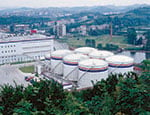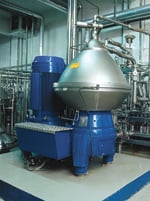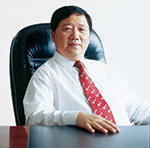Chinese Angel Yeast on the rise
Powered by abundant electricity, Angel Yeast is spreading not only across China and the rest of Asia, but around the world.
DATE 2023-11-28 AUTHOR Henry James Lu Yichang, a city of 4 million in China's Hubei Province, is known in China for its hydroelectricity. The Gezhouba Dam Hydroelectric Project, the first of a number of massive water-management projects planned along the Yangtze River, sits on the outskirts of Yichang, less than 40 kilometers (25 miles) downriver from the giant Three Gorges Dam.
Yichang, a city of 4 million in China's Hubei Province, is known in China for its hydroelectricity. The Gezhouba Dam Hydroelectric Project, the first of a number of massive water-management projects planned along the Yangtze River, sits on the outskirts of Yichang, less than 40 kilometers (25 miles) downriver from the giant Three Gorges Dam.
Abundant and cheap electricity was a main reason for choosing Yichang as the home of Hubei Angel Yeast, founded in 1988. The company is one of 56 manufacturing projects sponsored by the central Beijing government in the 1980s.
Angel Yeast has emerged a dominant player in both China and Asia as a whole. It has built marketing networks across China and is represented in more than 20 countries in Europe, Africa, Central Asia and Southeast Asia, with exports climbing to 20 percent of sales last year.
Pricing and service crucial
 The company's products are mostly for bakeries but also for breweries, food businesses, aquatic farms, medicine and healthcare applications.
The company's products are mostly for bakeries but also for breweries, food businesses, aquatic farms, medicine and healthcare applications.
Thirty-five-year-old Xiao Minghua, deputy general manager in charge of equipment maintenance and procurement, is too young to have seen the 1988 arrival of Angel Yeast's first purchases from Alfa Laval. But he did oversee the acquisition of further purchases from 1994 to 1997, when Angel Yeast made significant upgrades to its production facilities.
"Alfa Laval is one of the two top suppliers of yeast separators" says Xiao. "And the one we are most familiar with."
Alfa Laval managed to win most of Angel Yeast's business by competitive pricing and excellent service. Xiao says the company's technical support and after-sales service are important. "We are treated as a key account," he explains.
Growing to a global top five
 Cash-rich following a Shanghai stock exchange listing in August 2000, Angel Yeast is trying to grow in China through acquisition. Yu Xuefeng, Angel Yeast's chairman, is cautious in discussing specific projects, but says he hopes the company will be one of the top five yeast makers in the world within five to 10 years.
Cash-rich following a Shanghai stock exchange listing in August 2000, Angel Yeast is trying to grow in China through acquisition. Yu Xuefeng, Angel Yeast's chairman, is cautious in discussing specific projects, but says he hopes the company will be one of the top five yeast makers in the world within five to 10 years.
"As more and more Chinese move to urban lifestyles, convenience and cleanliness become the top concerns people have in relation to food," Yu says. "We're working to leverage these concerns in promoting the use of yeast in food."
 As an example, Angel Yeast is leading a campaign to create a bakers' sub-council within the China Baking Association. And through a pop-up window on the home page of its Web site, the company is showing DIY (do-it-yourself) bakers how to bake their own bread. "Many Chinese in Singapore and Malaysia bake for pleasure," Yu says, "and we anticipate that some day this will be widespread in China as well."
As an example, Angel Yeast is leading a campaign to create a bakers' sub-council within the China Baking Association. And through a pop-up window on the home page of its Web site, the company is showing DIY (do-it-yourself) bakers how to bake their own bread. "Many Chinese in Singapore and Malaysia bake for pleasure," Yu says, "and we anticipate that some day this will be widespread in China as well."
High technical standard
Yu expresses the hope that Angel Yeast will be a leader not only in market share, but also technologically. He says he is proud of his company's recruitment of technical staff from around the country: Technicians account for 80 percent of staff, 35 percent of them being senior professionals.
"We are a listed company and funding is not an issue for us at the moment," says Yu."More important is making the technical advances that can drive us ahead in the market. Technology-wise, partly thanks to our partnership with Alfa Laval, we can compete globally. Our suppliers and equipment compare well with those of any of the big names in our industry."
Making perfect yeast
Chinese producer Angel Yeast makes its yeast from "slant agar" cultures.
Cultivating slant agar cultures into yeast cream is a one-to-billions process. A few yeast microbes are first developed in a test tube, and then put into 20-liter (5-gallon) containers to ferment. They breed once every two hours, feeding on molasses (the leftovers of sugar pressing), which are treated and mixed in with the developing microbes.
Because purity is vital, waste is removed from the molasses with separators before the molasses is fed to the slant agar cultures. The better the separators, the fewer impurities get into the yeast cream.
Massive growth
After sterile fermentation, the microbes and the molasses have grown enough to fill a 200-cubic-meter (52,000-gallon) storage tank, where they are prepared for commercial fermentation.
By this time, the original test tube of microbes has developed into 10 metric tons (9 tons) of watery yeast, which is then sent again to the separator for dehydration. Here the watery yeast is reduced to 20 percent of its full weight.
After the yeast cream has been treated in a huge filtration machine, the yeast content is increased to 35 percent, and the mixture turns into yeast powder.
This powder is then dried to further reduce the water content to 25 percent before it is ready for storage or packaging.
Crucial process
The final heating/drying process is crucial, explains Xiao Minghua, Angel Yeast's deputy general manager. The Alfa Laval plate heat exchangers are used here.
Xiao says: "We use Alfa Laval separators to keep purity high and ensure cleaner yeast. We prefer to use foreign-made equipment because the entire yeast production process must be conducted in an airtight, bacteria-free environment, and foreign manufacturers in general are able to deliver higher quality in this area."
Xiao also points out that higher-quality equipment makes the whole system highly controllable so that it can be better adapted to the needs of the yeast as it grows.
To date, Angel Yeast has purchased 16 separators and some 20 plate heat exchangers from Alfa Laval.
